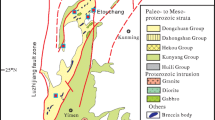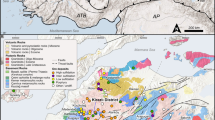Abstract
We present new Re–Os molybdenite age data on three porphyry Cu–Mo–Au deposits (Yulong, Machangqing, and Xifanping). These deposits are associated with the Himalayan adakitic magmatism that occurred in a continental collision environment, controlled by large-scale Cenozoic strike-slip faults in the eastern Indo–Asian collision zone. Three distinct episodes of Cu–Mo–Au mineralization are recognized. At Yulong, Re–Os isotopic data of four molybdenite samples from sulfide-quartz veins in the quartz–sericite alteration zone yield an isochron with an age of 40.1±1.8 Ma (2σ), coincident to a zircon sensitive high-mass resolution ion microprobe (SHRIMP) age of 40.9±0.1 Ma for the host monzogranite. The molybdenite Re–Os dates, together with K–Ar, Rb–Sr, U–Pb, and 40Ar/39Ar dates on the pre- and intra-ore porphyries, suggest that Cu–Mo–Au mineralization formed during the late stage (∼40 Ma) of regional porphyry magmatism, but hydrothermal activity probably lasted to at least ∼36 Ma. At Machangqing, molybdenite Re–Os data from the K–silicate and quartz–sericite alteration zones yield an isochron with an age of 35.8±1.6 Ma (2σ), which is identical to the zircon SHRIMP and bulk-rock Rb–Sr ages (35∼36 Ma) of the host granite, but older than bulk-rock K–Ar dates (31∼32 Ma) for associated Au-bearing quartz syenite with advanced argillic alteration. At Xifanping, five molybdenite samples from the K–silicate alteration zone yield the youngest Re–Os isochron age in the area, at 32.1±1.6 Ma (2σ). The Re–Os molybdenite dates here are younger than K–Ar ages (33.5∼34.6) for hydrothermal biotite and actinolite. There is a positive correlation between the absolute age of the deposits and their Cu and Au reserves in the eastern Indo–Asian collisional zone. Episodic stress relaxation probably caused multiple magmatic intrusions, which most likely resulted in three episodes of Cu–Mo–Au mineralization in the eastern Indo–Asian collision zone.




Similar content being viewed by others
References
Ayres D (1974) Distribution and occurrence of some naturally-occurring polytypes of molybdenite in Australia and Papua New Guinea. J Geol Soc Aust 21:273–278
Barra F, Ruiz J, Mathur R, Titley S (2003) A Re–Os study of sulfide minerals from the Bagdad porphyry Cu–Mo deposit, northern Arizona, USA. Miner Depos 38:585–596
Ballard JR, Palin JM, Williams IS, Campbell IH (2001) Two ages of porhyryr intrusion resolved for the super-giant Chuquicamata copper deposit of northern Chile by ELA-ICP-MS and SHRIMP. Geology 29:383–386
Bernard A, Symonds RS, Rose WI (1990) Volatile transport and deposition of Mo, W and Re in high temperature magmatic fluids. Appl Geochem 5:317–326
Cai X-P (1992) Deep-sourced exclave within the Cenozoic alkali porphyry in the West rim of Yangtze Craton and its significance. Chin J Geol 27:183–189 (in Chinese)
Candela PA, Holland HD (1984) The partitioning of copper and molybdenum between silicate melt and aqueous fluids. Geochim Cosmochim Acta 48:373–380
Chen W-M (1983) Relationship of the Yulong porphyry copper deposit with sandstone copper deposits. Contribution to Geology in the Qinghai-Tibet Plateau (13), Geological Publishing House, Beijing (in Chinese)
Clack AH (1993) Are outside porphyry copper deposits either anatomically or environmentally distinctive? Soc Econ Geol Spec Publ 2:213–283
Defant MJ, Drummond MS (1990) Derivation of some modern arc magmas by melting of young subducted lithosphere. Nature 34:662–665
Drummond MS, Defant MJ, Kepezhinskas PK (1996) Petrogenesis of slab-derived trondhjemite-tonalite-dacite/adakite magmas. Trans R Soc Edinb Earth Sci 87:205–215
Du A-D, He H-L, Yin W-N (1994) The study on the analytical methods of Re–Os age for molybdenites. Acta Geol Sin 68:339–346 (in Chinese with English abstract)
Fu D-M (1996) Metallogenic series and regularity of the ferrous and rare, and precious metal ore deposits in the continental orogenic belt, southwestern margins of the Yangtze platform. In: Luo Y-N (ed) Contribution to geology and mineral resources in the continental orogenic belt, southwestern margins of the Yangtze platform. Sichuan Press of Science and Technology, Chengdu, pp 120–129
Ge L-S, Guo X-D, Zhou Y-L, Yang J-H, Li Y-J (2003) Geology and origin of the Yao’an gold deposit, Yunnan, related to alkai-rich magmatism. Geol Resour 10:29–37 (in Chinese)
Giles DL, Schilling JH (1972) Variation in rhenium content of molybdenite. In: 24th International Geological Congress, Montreal Proceedings, vol 10. pp 145–152
Hou Z-Q, Ma H-W, Zaw K, Zhang Y-Q, Wang M-J, Wang Z, Pan G-T, Tang R-L (2003) The Himalayan Yulong porphyry copper belt: produced by large-scale strike-slip faulting at Eastern Tibet. Econ Geol 98:125–145
Hou Z-Q, Zhong D-L, Deng W-M (2004a) A tectonic model for porphyry copper–molybdenum–gold deposits in the eastern Indo–Asian collision zone. Geol China 31:1–14 (in Chinese)
Hou Z-Q, Qu X-M, Wang S-X, Du A-D, Gao Y-F (2004b) Re–Os age for molybdenites from the Gangdese porphyry copper belt in the Tibetan plateau: implication to mineralization duration and geodynamic setting. Sci China 47:221–231
Hou Z-Q, Xie Y-L, Li Y-Q, Xu W-Y, Rui Z-Y (2005) Yulong: a high-sulfidation Cu–Au porphyry copper deposit in the eastern Indo–Asian collision zone, East Tibet. Int Geol Rev (in press)
Huang Z-L, Wang L-K, Zhu C-M (1996) Geochemistry and genesis of the lamprophyres in the Machangqing gold district, Yunnan. Miner Rocks 16:82–89 (in Chinese)
Ishihara S (1988) Rhenium contents of molybdenites in granitoid-series rocks in Japan. Econ Geol 83:1047–1051
Ishihara S, Shibata K, Uchiumi S (1989) K–Ar age of molybdenum mineralization in the east-central Kitakami Mountains, Northern Honshu, Japan: comparison with the Re–Os age. Geochem J 23:85–89
Kay SM, Ramos VA, Marquez M (1993) Evidence in Cerro Pampa volcanic rocks for slab-melting prior to ridge–trench collision in Southern South America. J Geol 101:703–714
Keppler H, Wyllie PJ (1991) Partitioning of Cu, Sn, Mo, W, U, and Th between melt and aqueous fluid in the systems haplogranite-H2O–HCl and haplogranite-H2O–HF. Contrib Mineral Petrol 109:139–150
Leloup PH, Lacassin R, Tapponnier R (1995) Kinematics of Tertiary left-lateral shearing at the lithospheric-scale in the Ailao Shan–Red River shear zone (Yunnan, China). Tectonophysics 251:3–84
Li Y-Q, Rui Z-Y, Cheng L-X (1981) Fluid inclusions and mineralization of the Yulong porphyry copper (Mo) deposit. Acta Geol Sin 55:18–23 (Chinese with English abstract)
Liang H-Y (2002) The zircon SHRIMP ages of the Yulong porphyry Cu belt. Report to National Foundation of Natural Science in China (in Chinese)
Liu R-M, Zhao D-H, Huang X-R (1981) Discussion on isotopic ages of acid intrusions in the eastern Tibet. Geol Rev 27:326–332 (in Chinese with English abstract)
Liu Y-M, Wang C-L, Qi Y-Z, Lu H-Z (1999) Metallogenic feature and genetic model of the Shizhuyuan W-polymetallic deposit in China. In Tu G-Z (ed) Super-large deposits in China. Academic Press, Beijing, pp 27–48 (in Chinese)
Luck JM, Allègre CJ (1982) The study of molybdenites through the 187Re–187Os chronometer. Earth Planet Sci Lett 61:291–296
Ludwig KR (2001) Isoplot/Ex version 2.49. A geochronological toolkit for Microsoft Excel. Berkeley Geochronological Center Spec Publ 1a
Luo Y-N, Yu R-L, Hou L-W, Lai S-M, Fu D-M, Chen M-X, Fu X-F, Rao R-B, Zhou S-Q (1998) Longmenshan–Jinpingshan intracontinental orogenic belt. Sichuan Science and Technology Publishing House, Chengdu, p 171 (in Chinese)
Ma H-W (1990) Granitoids and mineralization of the Yulong porphyry copper belt in eastern Tibet. Press of China University of Geosciences, Beijing, p 157 (Chinese with English abstract)
McCandless TE, Ruiz J, Campbell AR (1993) Rhenium behavior in molybdenite in hypogene and near-surface environments: implications for Re–Os geochronology. Geochim Cosmochim Acta 57:889–905
Minster JF, Richard LP, Allègre CJ (1979) 87Rb–87Sr chronology of enstatite meteorites. Earth Planet Sci Lett 44:420–440
Mo X-X, Lu F-X, Shen S-Y, Zhu Q-W, Hou Z-Q, Yang K-H (1993) Sanjiang Tethyan volcanism and related mineralization. Geological Publishing House, Beijing, p 267 (in Chinese with English abstract)
Newberry RJ (1979) Ploytypism in molybdenite (II): relationships between polytypism, ore deposition/alteration stages and rhenium contents. Am Mineral 64:768–775
Padilla Garza RA, Titley SR, Pimentel F (2001) Geology of the Escondida porphyry copper deposit, Antofagast region, Chile. Econ Geol 96:307–324
Peng Z, Watanabe M, Hoshino K, Sueoka S, Yano T, Nishido H (1998) The Machangqing copper–molybdenum deposit, Yunnan, China: an example of Himalayan porphyry-hosted Cu–Mo mineralization. Mineral Petrol 63:95–117
Rui Z-Y, Huang C-K, Qi G-M, Xu J, Zhang M-T (1984) The porphyry Cu (–Mo) deposits in China. Geological Publishing House, Beijing, p 350 (in Chinese with English abstract)
Selby D, Creaser RA (2001) Re–Os geochronology and systematics in molybdenite from the Endako porphyry molybdenum deposit, British Columbia, Canada. Econ Geol 96:197–204
Selby D, Creaser RA, Hart CJR, Rombach CS, Thompson JFH, Smith MT, Bake AA, Goldfarb RJ (2002) Absolute timing of sulfide and gold mineralization: a comparison of Re–Os molybdenite and Ar–Ar mica methods from the Tintina Gold Belt, Alaska. Geology 30:791–794
Shirey SB, Walker RJ (1995) Carius tube digestion for low-blank rhenium–osmium analysis. Anal Chem 67:2136–2141
Sillitoe RH (1988) Epochs of intrusion-related copper mineralization in the Andes. J South Am Earth Sci 1:89–108
Smoliar MI, Walker RJ, Morgan JW (1996) Re–Os ages of group IIA, IIIA, IVA and IVB iron meteorites. Science 271:1099–1102
Stein HJ, Markey RJ, Morgan JW, Du A-D, Sun Y-L (1997) Highly precise and accurate Re–Os ages for molybdenite from the East Qinling molybdenite belt, Shananxi Province, China. Econ Geol 92:827–835
Stein HJ, Sundblad K, Markey RJ, Morgan JW, Motuza G (1998) Re–Os ages for Archean molybdenite and pyrite, Kuittila-Kiviso, Finland and Proterozoic molybdenite, Kabeliai, Lithuania: testing the chronometer in a metamorphic and metasomatic setting. Miner Depos 33:329–345
Suzuki K, Shimizu H, Masuda A (1996) Re–Os dating of molybdenites from ore deposits in Japan: implication for the closure temperature of the Re–Os system for molybdenite and the cooling history of molybdenum ore deposits. Geochim Cosmochim Acta 60:3151–3159
Tapponnier P, Lacassin R, Leloup PH, Scharer U, Zhong D-L, Haiwei W, Liu X-H, Ji S-C, Zhang L-S, Zhong J-Y (1990) The Ailao Shan/Red River metamorphic belt: Tertiary left-lateral shear between Indochina and South China. Nature 343:431–437
Wang D-H, Chen Y-C, Xu J, Yang J-M, Xue C-J, Yan S-H (2001) Major characteristics and mineralized series of the Cenozoic metallogeny in China. Contribution to the 31st International Geological Congress, 264–269 (in Chinese)
Wang J-H, Yin A, Harrison TM (2001) A tectonic model for Cenozoic igneous activities in the eastern Indo–Asian collision zone. Earth Planet Sci Lett 88:123–133
Wang J-Q, Hu R-Z, Sun Y, Lu Y, Li Z-Q (2002) Geochemical studies of K silicate alteration in the Xifanping porphyry Cu deposit. Miner Rocks 22:41–45 (in Chinese)
Watanabe Y, Stein HJ, Morgan JW, Markey RJ (1999) Re–Os geochronology brackets timing and duration of mineralization for the El Salvador porphyry Cu–Mo deposit, Chile (abstract). Geol Soc Am Abs with Prog 31:A30
Xu S-J, Shen W-Z, Wang R-C, Lu J-J, Lin Y-P, Ni P, Luo Y-N, Li L-Z (1997) Characteristics and origin of the Xifanping porphyry copper deposit, Yanyuan County, Sichuan Province. Acta Miner Sin 17:56–62 (in Chinese with English abstract)
Yang J-K, Tang Z-G (1996) Mineralization characteristics and prospective prediction of the Cenozoic porphyry gold deposit in Yunnan Province: exampled by Machangqing gold deposit. Geol Beijing 3:27–31 (in Chinese)
Zhang Y-Q, Xie Y-W (1997) Geochronology and Nd–Sr isotopic features of alkali-rich intrusions in the Ailaoshan-Jinshajiang region. Sci China 27:289–293 (in Chinese)
Zhang Y-Q, Xie Y-W, Qiu H-N, Li X-H, Zhong S-L (1998a) Shoshonitic series: geochemical characteristics of elements for ore-bearing porphyry from Yulong copper ore belt in Eastern Tibet. Earth Sci J China Univ Geosci 23:557–561 (in Chinese)
Zhang Y-Q, Xie Y-W, Qiu H-N, Li X-H, Zhong S-L (1998b) Shoshonitic series: Sr, Nd, and Pb isotopic compositions of ore-bearing porphyry for Yulong copper ore belt in the Eastern Tibet. Sci Geol Sin 33:359–366 (in Chinese with English abstract)
Acknowledgements
This study is supported by the National Basin Research Program (2002CB41260 to Hou Z-Q) from the Ministry of Science and Technology, China. We thank Dr. Qu, W-J for assistance in the Re–Os isotope analysis, and mining geologists for help with the fieldwork. We are deeply indebted to Drs. David Selby and Marc Norman for their incisive reviews, constructive comments, and useful suggestions to improve the earlier draft of this manuscript.
Author information
Authors and Affiliations
Corresponding author
Additional information
Editorial handling: G. Beaudoin
Rights and permissions
About this article
Cite this article
Hou, Z., Zeng, P., Gao, Y. et al. Himalayan Cu–Mo–Au mineralization in the eastern Indo–Asian collision zone: constraints from Re–Os dating of molybdenite. Miner Deposita 41, 33–45 (2006). https://doi.org/10.1007/s00126-005-0038-2
Received:
Accepted:
Published:
Issue Date:
DOI: https://doi.org/10.1007/s00126-005-0038-2




